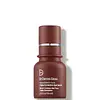What's inside
What's inside
 Key Ingredients
Key Ingredients

 Benefits
Benefits

 Concerns
Concerns

 Ingredients Side-by-side
Ingredients Side-by-side

Water
Skin ConditioningGlycerin
HumectantButylene Glycol
HumectantImperata Cylindrica Root Extract
Skin ConditioningDimethyl Isosorbide
SolventMeadowfoam Delta-Lactone
Skin ConditioningRetinyl Propionate
Skin ConditioningRetinol
Skin ConditioningSwertia Chirata Leaf Extract
AstringentUrea
BufferingYeast Amino Acids
HumectantTrehalose
HumectantInositol
HumectantTaurine
BufferingBetaine
HumectantFucus Vesiculosus Extract
EmollientGlycine Soja Extract
Skin ConditioningMacrocystis Pyrifera Extract
Skin ConditioningIsopropyl Palmitate
EmollientLecithin
EmollientPvp
Emulsion StabilisingHexylene Glycol
EmulsifyingCaprylyl Glycol
EmollientPunica Granatum Seed Oil
EmollientCaprylic/Capric Triglyceride
MaskingPvm/Ma Decadiene Crosspolymer
PEG-8
HumectantCarbomer
Emulsion StabilisingSodium Bisulfite
AntioxidantSilica
AbrasiveSodium Hydroxide
BufferingChlorphenesin
AntimicrobialPhenoxyethanol
PreservativeParfum
MaskingCI 77891
Cosmetic ColorantSynthetic Fluorphlogopite
CI 14700
Cosmetic ColorantCI 19140
Cosmetic ColorantWater, Glycerin, Butylene Glycol, Imperata Cylindrica Root Extract, Dimethyl Isosorbide, Meadowfoam Delta-Lactone, Retinyl Propionate, Retinol, Swertia Chirata Leaf Extract, Urea, Yeast Amino Acids, Trehalose, Inositol, Taurine, Betaine, Fucus Vesiculosus Extract, Glycine Soja Extract, Macrocystis Pyrifera Extract, Isopropyl Palmitate, Lecithin, Pvp, Hexylene Glycol, Caprylyl Glycol, Punica Granatum Seed Oil, Caprylic/Capric Triglyceride, Pvm/Ma Decadiene Crosspolymer, PEG-8, Carbomer, Sodium Bisulfite, Silica, Sodium Hydroxide, Chlorphenesin, Phenoxyethanol, Parfum, CI 77891, Synthetic Fluorphlogopite, CI 14700, CI 19140
Water
Skin ConditioningPropylene Glycol
HumectantEthoxydiglycol
HumectantBakuchiol
AntimicrobialRetinol
Skin ConditioningNephelium Lappaceum Leaf Extract
Skin ConditioningFerulic Acid
AntimicrobialUbiquinone
AntioxidantQuercetin
AntioxidantCamellia Sinensis Leaf Extract
AntimicrobialSodium Hyaluronate
HumectantSaccharide Isomerate
HumectantPhospholipids
Skin ConditioningCentella Asiatica Extract
CleansingCaffeine
Skin ConditioningSalix Alba Bark Extract
AstringentSalicylic Acid
MaskingArctostaphylos Uva-Ursi Leaf Extract
Skin ConditioningMorus Alba Bark Extract
Skin ConditioningGlycyrrhiza Glabra Root Extract
BleachingPotassium Azeloyl Diglycinate
Skin ConditioningGlycolic Acid
BufferingPanthenol
Skin ConditioningButylene Glycol
HumectantTetrapeptide-21
Skin ConditioningCaprylic/Capric Triglyceride
MaskingGlycerin
HumectantLeuconostoc/Radish Root Ferment Filtrate
AntimicrobialMandelic Acid
AntimicrobialPotassium Hydroxide
BufferingMaltodextrin
AbsorbentPvm/Ma Decadiene Crosspolymer
Polysorbate 20
EmulsifyingCitric Acid
BufferingSodium Citrate
BufferingPhenoxyethanol
PreservativeSodium Benzoate
MaskingPotassium Sorbate
PreservativeIron Oxides
Water, Propylene Glycol, Ethoxydiglycol, Bakuchiol, Retinol, Nephelium Lappaceum Leaf Extract, Ferulic Acid, Ubiquinone, Quercetin, Camellia Sinensis Leaf Extract, Sodium Hyaluronate, Saccharide Isomerate, Phospholipids, Centella Asiatica Extract, Caffeine, Salix Alba Bark Extract, Salicylic Acid, Arctostaphylos Uva-Ursi Leaf Extract, Morus Alba Bark Extract, Glycyrrhiza Glabra Root Extract, Potassium Azeloyl Diglycinate, Glycolic Acid, Panthenol, Butylene Glycol, Tetrapeptide-21, Caprylic/Capric Triglyceride, Glycerin, Leuconostoc/Radish Root Ferment Filtrate, Mandelic Acid, Potassium Hydroxide, Maltodextrin, Pvm/Ma Decadiene Crosspolymer, Polysorbate 20, Citric Acid, Sodium Citrate, Phenoxyethanol, Sodium Benzoate, Potassium Sorbate, Iron Oxides
Ingredients Explained
These ingredients are found in both products.
Ingredients higher up in an ingredient list are typically present in a larger amount.
Butylene Glycol (or BG) is used within cosmetic products for a few different reasons:
Overall, Butylene Glycol is a safe and well-rounded ingredient that works well with other ingredients.
Though this ingredient works well with most skin types, some people with sensitive skin may experience a reaction such as allergic rashes, closed comedones, or itchiness.
Learn more about Butylene GlycolThis ingredient is an emollient, solvent, and texture enhancer. It is considered a skin-softener by helping the skin prevent moisture loss.
It helps thicken a product's formula and makes it easier to spread by dissolving clumping compounds.
Caprylic Triglyceride is made by combining glycerin with coconut oil, forming a clear liquid.
While there is an assumption Caprylic Triglyceride can clog pores due to it being derived from coconut oil, there is no research supporting this.
Learn more about Caprylic/Capric TriglycerideGlycerin is already naturally found in your skin. It helps moisturize and protect your skin.
A study from 2016 found glycerin to be more effective as a humectant than AHAs and hyaluronic acid.
As a humectant, it helps the skin stay hydrated by pulling moisture to your skin. The low molecular weight of glycerin allows it to pull moisture into the deeper layers of your skin.
Hydrated skin improves your skin barrier; Your skin barrier helps protect against irritants and bacteria.
Glycerin has also been found to have antimicrobial and antiviral properties. Due to these properties, glycerin is often used in wound and burn treatments.
In cosmetics, glycerin is usually derived from plants such as soybean or palm. However, it can also be sourced from animals, such as tallow or animal fat.
This ingredient is organic, colorless, odorless, and non-toxic.
Glycerin is the name for this ingredient in American English. British English uses Glycerol/Glycerine.
Learn more about GlycerinPhenoxyethanol is a preservative that has germicide, antimicrobial, and aromatic properties. Studies show that phenoxyethanol can prevent microbial growth. By itself, it has a scent that is similar to that of a rose.
It's often used in formulations along with Caprylyl Glycol to preserve the shelf life of products.
We don't have a description for Pvm/Ma Decadiene Crosspolymer yet.
Retinol is a gold-standard ingredient for anti-aging. It is a form of Vitamin A and belongs to the class of retinoids that also includes tretinoin.
Why is retinol famous?
It has the most scientific studies backing up its skin benefits out of all the non-prescription ingredients.
Retinol is proven to:
This is why retinol is effective at removing wrinkles, fading dark spots, treating acne, and reducing the appearance of pores.
Studies show retinol is less effective when exposed to UV. Be sure to look for appropriate packaging to keep your retinol potent (similar to Vitamin C).
Using retinol or any retinoids will increase sun-sensitivity in the first few months. Though studies show retinoids increase your skin's natural SPF with continuous use, it is best to always wear sunscreen and sun-protection.
We recommend speaking with a medical professional about using this ingredient during pregnancy.
Retinol may cause irritation in some people, so be sure to patch test. Experts recommend 'ramping up' retinol use: start using this ingredient once a week and work up to using it daily.
Read about Tretinoin
Learn more about RetinolWater. It's the most common cosmetic ingredient of all. You'll usually see it at the top of ingredient lists, meaning that it makes up the largest part of the product.
So why is it so popular? Water most often acts as a solvent - this means that it helps dissolve other ingredients into the formulation.
You'll also recognize water as that liquid we all need to stay alive. If you see this, drink a glass of water. Stay hydrated!
Learn more about Water